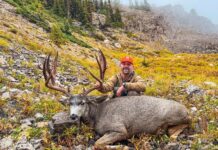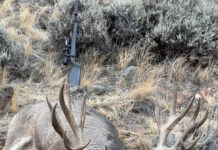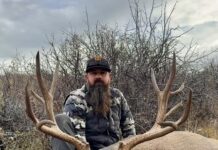I’ve written a lot these last few weeks on hunt planning and the western draws. If you’re just tuning in, review those blogs. I’d now like to share my personal application strategy in hopes it might help you in some way.
We were hoping to get this blog started by January 1st so we could be ahead of the deer application deadlines for the western states, but with the business side of Rokslide taking so much time, it didn’t happen. However, I still think it’s worth diving into although the Utah, New Mexico, Montana, and Wyoming application deadlines have passed.
I’ve written before about treating your hunt application strategy like you would an investment portfolio. After all, that’s what it is: an investment in your hunting future. Just like an investment portfolio, conditions will change that require you to change your strategies.
The Arizona deer application isn’t due till late June, but I start my application season early January by applying for my license in the elk/antelope draw. That way, I can get a bonus point for elk for less than 10 bucks.
I only hunt deer at this point in my life as it takes so much time to be successful. However, gagger bull elk are an incredible animal, and I’d like to have a little opportunity in the bank for when I’m older.
Arizona’s class G, General Hunting License runs $151.25 and is non-refundable. The license is a good value to me for two reasons:
1) I have seven deer points and the hunter education point and the loyalty point, so I’m worth nine.
2) Arizona’s conservative management system and tolerable draw odds for decent hunts
The best hunts for big deer in Arizona are the late hunts north of the Colorado River. However, with the current bonus point system almost guaranteeing that the allocated non-resident tags go to the max-bonus point holders, I have zero chance of drawing them. However, there are big deer available on earlier hunts and with different weapons that can still be drawn.
If draw odds continue to worsen across the West, I may be wasting money like I have in Oregon and Montana, but at this point, I’m staying in. Interestingly enough, with Arizona’s deer application not due until late June, some years I only apply for points as I’ve already found out I’m going hunting somewhere else.
Utah is next on my list. I have 13 deer bonus points there, which sounds like a lot, but in reality, it’s not. I’m in a virtual no-man’s land—too many points to waste but not near enough to land a great tag. As their license averages $30 bucks a year, I’m going to stay in the game. I applied for a great tag there this year, but am just planning on the point.
I also kick in the extra few bucks for Utah’s general season preference point in case things ever change and hunting improves. However, I’m well aware that thousands of other hunters are doing the same. My future draw odds aren’t that great, but it fits my budget, so I do it.
New Mexico (NM) used to be on my list for one of the low-odds draw tags as they didn’t charge much up front and they don’t have a points system, so my chances were as good as anyone’s.
In 2012, NM began requiring a $65 non-refundable license to apply (correction, the license fee is refundable, but the $20 app fee is not, my mistake). Although there was chatter that draw odds might improve due to the price increase, draw odds on the good hunts actually plummeted by 50%.
This happened, in part, because NM cut the non-resident DIY quotas in half, from 12% to 6%. I’m glad I saved my money. For now, I’m done with the Enchanted State. If you live close to NM and are willing to scout, it could still be worth hunting their non-premium units. Like all states, not all the big bucks live in the draw units.
Things change yearly that affect your opportunity, both good and bad. This is why you have to stay on top of all the states where you apply.
I’ll cover Montana, Oregon, and Wyoming in the next blog.




















Robby,
One little correction. If you don’t draw in New Mexico, I’m fairly certain you have the option to get a refund of the $65 hunting license fee. Thanks for the great info as always!
Jason, you’re right! I misquoted that. It’s the $20 application fee that’s not refundable, not the $65 license. Thanks for catching that.
Robby It was nice speaking to you yesterday. I just read your comments on western big game draws. Good work. I have 9 pts. for Colorado deer with the deadline approaching I am struggling with what to do. For Arizona deer I am 1 pt. short of max. I thought I had a chance to draw the strip is that really not true?
Hi Jeff,
yes, unfortunately it’s true you have zero chance on the late Strip 13B tags IF YOU ARE A NON-RESIDENT. Even drawing the late 13A and Kaibab tags are almost impossible if you are even one point below max. I’ll try to explain it here, but you should check it our yourself.
Non-residents are limited to 10% of the tags. Arizona has a rule where the Max-Point holders are drawn first (basically their bonus points are treated as preference points). In the hunts with low tag #’s, like 50 tags, there are only 5 that can go to non-residents (10%). There are so many max point holders, they pick up those five tags in that draw, leaving none for less-than-max point holders.
The only hunts you can really draw north of the Colorado River are the early rifle, muzz, and archery hunts.
If you are only missing the Hunter Ed point, then get on a plane and get to Kingman for the class April 6th. That will put you in the max point pool for this years drawing. I took the class and am glad I did. You must have taken Hunter ED in your home state since 1980 and you fax your card to Dave Williams at AZ G&F @ 623-236-7903. Contact Williams @623-236-7434 to get signed up for the class!.
Robby
I did get the hunter ed. pt. years ago. AZFG said I must have missed a year. I don’t believe I let that happen, but that’s the way it is. I’m in denial.
Jeff, great you got the point. Just stay away from 13B so at least there’s a chance mathematically.
On Colorado, if I had 9 points, I’d be down there scouting this year preparing for next year. I’d look to 3rd or 4th seasons or early high country.
Comments are closed.